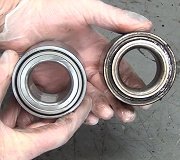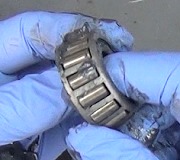Check and Replace the old caliper sleeve with a revised caliper sleeve. The new improved part is made of a harder material which is more resistant to wear spots and ridge formation.
BRAKES - ROUGHNESS CONCERN DURING BRAKE APPLICATION
TECHNICAL SERVICE BULLETIN
ISSUE
Early replacement of the brake components, rotors and pads due to brake roughness concern, is lowering customer's view of quality. The cause of brake roughness is due to small changes in braking torque when the brake is applied. The following are the major reasons for the brake torque variation:
� � � Runout of disc rotor
� � � Rusted rotor surface
� � � Warped rotor due to improper wheel lug nut tightening (torque too high or uneven)
� � � Varied rotor thickness around the disk
� � � Transferred patches of lining material on the rotor surface
� � � Uneven tire wear and balance
Begin with step 1 and finish with step 6.
1. Check the Condition of Tires and Their Balance.
Sometimes the brake roughness concern is not brake roughness at all. In fact, some complaints are due to the out-of-round and out-of-balance tires or broken steel cord (for steel belted radial tires) in the tires. The effects of these problems show up at all conditions of driving, but may seem worse when braking. That fact can be used to correctly determine that the customer is not experiencing brake-caused roughness. If however, there is brake roughness in addition to tire problems, then both problems must be repaired. If the inspection shows that tires are contributing to roughness (vibration or roughness present in all driving conditions, not just braking) they should first be balanced and rotated using normal maintenance procedures then follow the steps below to correct the brake roughness.
2. Check the Wheel Lug Nut Tightening Torque.
Uneven and/or out of specification torque on the wheel lug nuts will cause the brake rotors to warp. Up to 0.005 inch rotor runout can occur due to improper lug nut tightening. The first thing to check for is the consistency of torque of the lug nuts on each wheel. If the torque readings are not within 20% of each other, that gives an indication of a cause of the concern of brake roughness. Improper lug nut tightening can have the following order of effect:
a. Rotor runout b. Rotor thickness variation c. Brake torque variation d. Brake roughness
Ultimately, the rotor may be damaged and must be resurfaced. Follow the procedure in the Service Manual for resurfacing the rotors. Proper torque must be used when a resurfaced or new rotor is installed. Use of a torque wrench is again stressed, or as an alternative, the Rotunda "ACCUTORQ" 164-R0314 or equivalent must be used. When installing a new rotor, do not machine the rotor on a bench lathe. Any surface contamination can be removed with grease solvents or with very light hand sanding. Refer to #3, CHECK FOR RUST/ CONTAMINATION.
3. Check or Rust/Contamination on Mounting Surface
Surface rust or contaminations on the wheel-to-rotor and rotor-to-hub flange surfaces should be cleaned with very light hand sanding. Use garnet paper 100A or aluminum oxide 150J grit. DO NOT USE HARSH, ABRASIVE TOOLS. If the cleaning is not done, it will contribute to the runout of the rotor when assembled, which will cause brake roughness later on.
Any removal of rust on the rotor braking surfaces using harsh abrasive tools is not approved by Ford. The on-car turning procedure is the only sanctioned method at this time to deal with repairing rusty rotors. Since the thickness of the rotors are manufactured to less than 0.0004 inch tolerance, using hand held tools on the rotor surfaces can not guarantee maintaining the tolerance. Concerns will occur of brake roughness with rotor thickness variation of 0.0008 inch or less on certain very sensitive vehicles.
4. Check for Runout of the Front Rotor on the Car and Front Hub Mount 5. Check for Rear Brake Roughness
Except for the vehicles with separate drum in disc parking brake (e.G, Crown Victoria, Grand Marquis and Town Car) the rear brake can be actuated by actuating the parking brake. Attempt to slow down the vehicle from 48 km/h (30 mph) with the transmission in neutral using the parking brake. If roughness is present, then the rear brakes need to be serviced. If roughness is not present, then front brakes need servicing. To service the rear brakes follow the procedure, above for servicing the front brakes.
6. Check for Proper Caliper Operation
Inspect the calipers for leaks and brake fluid contamination. Any leaks from the wheel cylinders and seals must be repaired per the Service Manual. Also, inspect for glazing of the brake pads which may indicate a seized caliper piston, frequent severe or unintentional brake dragging by the customer.
Monday, September 27th, 2010 AT 6:19 AM


